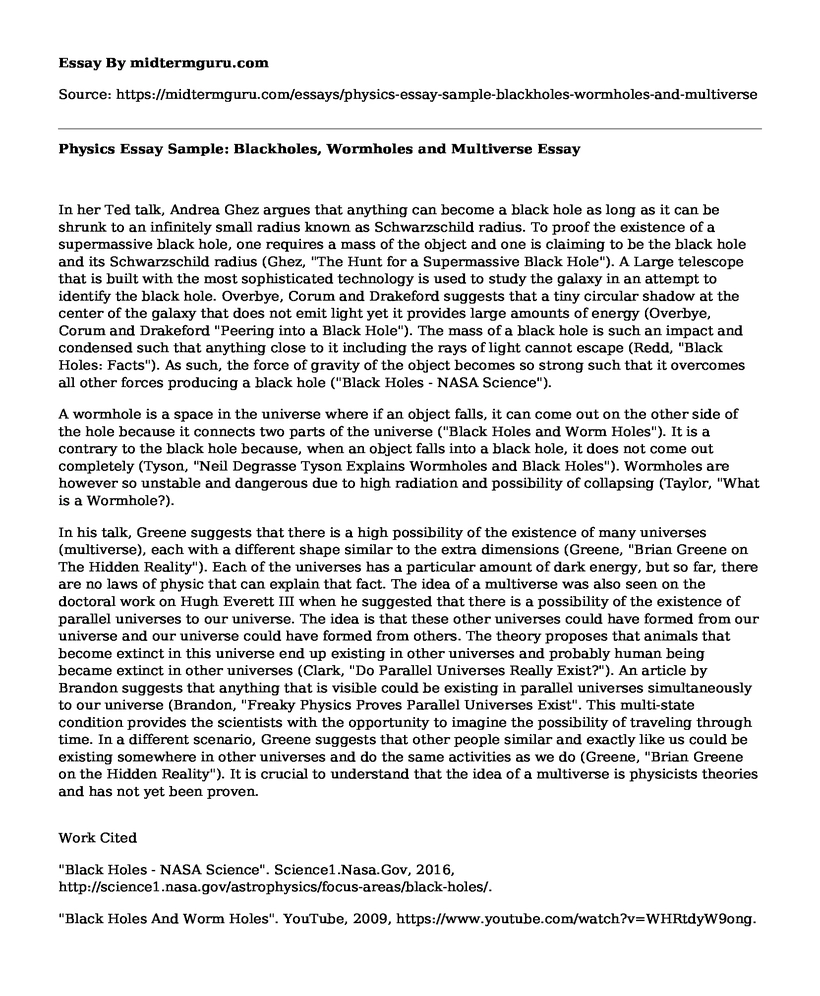In her Ted talk, Andrea Ghez argues that anything can become a black hole as long as it can be shrunk to an infinitely small radius known as Schwarzschild radius. To proof the existence of a supermassive black hole, one requires a mass of the object and one is claiming to be the black hole and its Schwarzschild radius (Ghez, "The Hunt for a Supermassive Black Hole"). A Large telescope that is built with the most sophisticated technology is used to study the galaxy in an attempt to identify the black hole. Overbye, Corum and Drakeford suggests that a tiny circular shadow at the center of the galaxy that does not emit light yet it provides large amounts of energy (Overbye, Corum and Drakeford "Peering into a Black Hole"). The mass of a black hole is such an impact and condensed such that anything close to it including the rays of light cannot escape (Redd, "Black Holes: Facts"). As such, the force of gravity of the object becomes so strong such that it overcomes all other forces producing a black hole ("Black Holes - NASA Science").
A wormhole is a space in the universe where if an object falls, it can come out on the other side of the hole because it connects two parts of the universe ("Black Holes and Worm Holes"). It is a contrary to the black hole because, when an object falls into a black hole, it does not come out completely (Tyson, "Neil Degrasse Tyson Explains Wormholes and Black Holes"). Wormholes are however so unstable and dangerous due to high radiation and possibility of collapsing (Taylor, "What is a Wormhole?).
In his talk, Greene suggests that there is a high possibility of the existence of many universes (multiverse), each with a different shape similar to the extra dimensions (Greene, "Brian Greene on The Hidden Reality"). Each of the universes has a particular amount of dark energy, but so far, there are no laws of physic that can explain that fact. The idea of a multiverse was also seen on the doctoral work on Hugh Everett III when he suggested that there is a possibility of the existence of parallel universes to our universe. The idea is that these other universes could have formed from our universe and our universe could have formed from others. The theory proposes that animals that become extinct in this universe end up existing in other universes and probably human being became extinct in other universes (Clark, "Do Parallel Universes Really Exist?"). An article by Brandon suggests that anything that is visible could be existing in parallel universes simultaneously to our universe (Brandon, "Freaky Physics Proves Parallel Universes Exist". This multi-state condition provides the scientists with the opportunity to imagine the possibility of traveling through time. In a different scenario, Greene suggests that other people similar and exactly like us could be existing somewhere in other universes and do the same activities as we do (Greene, "Brian Greene on the Hidden Reality"). It is crucial to understand that the idea of a multiverse is physicists theories and has not yet been proven.
Work Cited
"Black Holes - NASA Science". Science1.Nasa.Gov, 2016, http://science1.nasa.gov/astrophysics/focus-areas/black-holes/.
"Black Holes And Worm Holes". YouTube, 2009, https://www.youtube.com/watch?v=WHRtdyW9ong.
Brandon. "Freaky Physics Proves Parallel Universes Exist". Fox News, 2010, http://www.foxnews.com/tech/2010/04/05/freaky-physics-proves-parallel-universes.html.
Clark, Josh. "Do Parallel Universes Really Exist?". HowStuffWorks, 2016, http://science.howstuffworks.com/science-vs-myth/everyday-myths/parallel-universe.htm.
Ghez, Andrea. "The Hunt for A Supermassive Black Hole". Ted.Com, 2009, https://www.ted.com/talks/andrea_ghez_the_hunt_for_a_supermassive_black_hole?languag#t-209469.
Greene, Brian. "Brian Greene On the Hidden Reality". NPR.Org, 2011, http://www.npr.org/2011/03/04/134265287/brian-greene-on-em-the-hidden-reality-em.
Greene, Brian. "Is Our Universe the Only Universe?". Ted.Com, 2012, https://www.ted.com/talks/brian_greene_why_is_our_universe_fine_tuned_for_life#t-827256.
Overbye, Dennis et al. "Peering into A Black Hole". Nytimes.Com - Video, 2016, https://www.nytimes.com/video/science/100000003725182/peering-into-a-black-hole.html.
Redd, Nola. "Black Holes: Facts". Space.Com, 2016, http://www.space.com/15421-black-holes-facts-formation-discovery-sdcmp.html.
Taylor, Nola. "What Is a Wormhole?". Space.Com, 2016, http://www.space.com/20881-wormholes.html.
Tyson, Neil. "Neil Degrasse Tyson Explains Wormholes and Black Holes". YouTube, 2015, https://www.youtube.com/watch?v=PtA7O3AOCPU.
Cite this page
Physics Essay Sample: Blackholes, Wormholes and Multiverse. (2021, May 27). Retrieved from https://midtermguru.com/essays/physics-essay-sample-blackholes-wormholes-and-multiverse
If you are the original author of this essay and no longer wish to have it published on the midtermguru.com website, please click below to request its removal:
- Physics Essay Sample: Blackholes, Wormholes and Multiverse
- Essay on Newly Implemented Executive Order on Immigration
- Essay on Structural Assimilation
- Essay Sample on Chemistry of Sediment and Water of Des Plains
- Essay Sample on Similarities and Differences Between Rome and Greece
- Inequalities: Understanding the Language of Math in Everyday Life - Essay Sample
- Exploring the Physical Geography and Societal Relationships of Papua New Guinea in Oceania - Essay Sample







